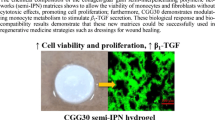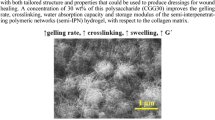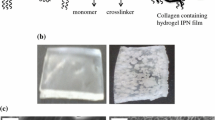Abstract
The preparation of hydrogels based on biopolymers like collagen and gum arabic gives a chance to provide novel options that can be used in biomedical field. Through a polymeric semi-interpenetration technique, collagen-based polymeric matrices can be associated with gum arabic while controlling its physicochemical and biological properties. To create novel hydrogels with their potential use in the treatment of wounds, the semi-interpenetration process, altering the concentration (0–40% by wt) of gum arabic in a collagen matrix is explored. The ability of gum arabic to create intermolecular hydrogen bonds in the collagen matrix enables the development of semi-interpenetrating polymeric networks (semi-IPN)-based hydrogels with a faster gelation time and higher crosslinking. Amorphous granular surfaces with linked porosity are present in matrices with 30% (by wt) of gum arabic, enhancing the storage modulus and thermal degradation resistance. The hydrogels swell to very high extent in hydrolytic and proteolytic environments, good hemocompatibility, and suppression of growth of pathogens like E. coli, and all it is enhanced by gum arabic included them, in addition to enabling the controlled release of ketorolac. The chemical composition of theses semi-IPN matrices have no deleterious effects on monocytes or fibroblasts, promoting their proliferation, and lowering alpha tumor necrosis factor (α-TNF) secretion in human monocytes.
Graphical abstract










Similar content being viewed by others
Data availability
Available upon request. No datasets have been used.
References
Ali BH, Ziada A, Blunden G (2009) Biological effects of gum arabic: a review of some recent research. Food Chem Toxicol 47:1–8. https://doi.org/10.1016/j.fct.2008.07.001
Ashcroft GS, Jeong MJ, Ashworth JJ, Hardman M, Jin W, Moutsopoulos N, Wild T, McCartney-Francis N, Sim D, McGrady G, Song XY, Wahl SM (2012) Tumor necrosis factor-alpha (TNF-alpha) is a therapeutic target for impaired cutaneous wound healing. Wound Repair Regen 20:38–49. https://doi.org/10.1111/j.1524-475x.2011.00748.x
Ashkani M, Kabiri K, Salimi A, Bouhendi H, Omidian H (2018) Hybrid hydrogel based on pre-gelatinized starch modified with glycidyl-crosslinked microgel. Iran Polym J 27(3):183–192. https://doi.org/10.1007/s13726-018-0599-4
Barnes LA, Marshall CD, Leavitt T, Hu MS, Moore AL, Gonzalez JG, Longaker MT, Gurtner GC (2018) Mechanical forces in cutaneous wound healing: emerging therapies to minimize scar formation. Adv Wound Care 7:47–56. https://doi.org/10.1089/wound.2016.0709
Barrientos S, Stojadinovic O, Golinko MS, Brem H, Tomic-Canic M (2008) Growth factors and cytokines in wound healing. Wound Repair Regen 16:585–601. https://doi.org/10.1111/j.1524-475x.2008.00410.x
Behravesh A, Shahrousvand M, Goudarzi A (2021) Poly(acrylic acid)/gum arabic/ZnO semi-IPN hydrogels: synthesis, characterization and their optimizations by response surface methodology. Iran Polym J 30:655–674. https://doi.org/10.1007/s13726-021-00920-1
Bratosin D, Mitrofan L, Palii C, Estaquier J, Montreuil J (2005) Novel fluorescence assay using calcein-AM for the determination of human erythrocyte viability and aging. Cytometry A 66:78–84. https://doi.org/10.1002/cyto.a.20152
Buckley MM, Brogden RN (1990) Ketorolac. A review of its pharmacodynamic and pharmacokinetic properties, and therapeutic potential. Drugs 39(1):86–109. https://doi.org/10.2165/00003495-199039010-00008
Claudio-Rizo JA, Mendoza-Novelo B, Delgado J, Castellano LE, Mata-Mata JL (2016) A new method for the preparation of biomedical hydrogels comprised of extracellular matrix and oligourethanes. Biomed Mater 11:035016. https://doi.org/10.1088/1748-6041/11/3/035016
Claudio-Rizo JA, Rangel-Argote M, Castellano LE, Delgado J, Mata-Mata JL, Mendoza-Novelo B (2017) Influence of residual composition on the structure and properties of extracellular matrix derived hydrogels. Mater Sci Eng C 79:793–801. https://doi.org/10.1016/j.msec.2017.05.118
Claudio-Rizo JA, Hernandez-Hernandez NG, Cano-Salazar LF, Flores-Guía TE, Cruz-Durán FN, Cabrera-Munguía DA, Becerra-Rodríguez JJ (2020) Novel semi-interpenetrated networks based on collagen-polyurethane-polysaccharides in hydrogel state for biomedical applications. J Appl Polym Sci 138:49739. https://doi.org/10.1002/app.49739
Coll Ferrer MC, Eckmann UN, Composto RJ, Eckmann DM (2013) Hemocompatibility and biocompatibility of antibacterial biomimetic hybrid films. Toxicol Appl Pharmacol 272:703–712. https://doi.org/10.1016/j.taap.2013.07.023
Doozandeh Z, Saber-Samandari S, Khandan A (2020) Preparation of novel Arabic gum-C6H9NO biopolymer as a bedsore for wound care application. Acta Med Iran. https://doi.org/10.18502/acta.v58i10.4915
Edwards R, Harding KG (2004) Bacteria and wound healing. Curr Pharm Des 17:91–96. https://doi.org/10.1097/00001432-200404000-00004
Gharee-Kermani M, Pham SH (2001) Role of cytokines and cytokine therapy in wound healing and fibrotic diseases. Curr Pharm Des 7:1083–1103. https://doi.org/10.2174/1381612013397573
Gils PS, Ray D, Sahoo PK (2010) Designing of silver nanoparticles in gum arabic based semi-IPN hydrogel. Int J Biol Macromol 46:237–244. https://doi.org/10.1016/j.ijbiomac.2009.12.014
Gunbas ID, Aydemir Sezer U, Gülce İz S, Deliloğlu Gürhan İ, Hasirci N (2012) Semi-IPN chitosan/PEG microspheres and films for biomedical applications: characterization and sustained release optimization. Ind Eng Chem Res 51:11946–11954. https://doi.org/10.1021/ie3015523
Heydary HA, Karamian E, Poorazizi E, Khandan A, Heydaripour J (2015) A novel nano-fiber of Iranian gum tragacanth-polyvinyl alcohol/nanoclay composite for wound healing applications. Proce Mat Sci 11:176–182. https://doi.org/10.1016/j.mspro.2015.11.079
Jaafar NS (2019) Clinical effects of Arabic gum (Acacia): A mini review. Iraqi J Pharm Sci 28:9–16. https://doi.org/10.31351/vol28iss2pp9-16
Jones A, Vaughan D (2005) Hydrogel dressings in the management of a variety of wound types: a review. J Orthop Nurs 9:S1–S11. https://doi.org/10.1016/S1361-3111(05)80001-9
Khan M, Shah LA, Rehman T, Khan A, Iqbal A, Ullah M, Alam S (2020) Synthesis of physically cross-linked gum Arabic-based polymer hydrogels with enhanced mechanical, load bearing and shape memory behavior. Iran Polym J 29:351–360. https://doi.org/10.1007/s13726-020-00801-z
Khandan A, Jazayeri H, Fahmy MD, Razavi M (2017) Hydrogels: types, structure, properties, and applications. Biomat Tiss Eng 4:143–169. https://doi.org/10.2174/9781681085364117040007
Li B, Wang JH (2011) Fibroblasts and myofibroblasts in wound healing: force generation and measurement. J Tissue Viab 20:108–120. https://doi.org/10.1016/j.jtv.2009.11.004
Li M, Li H, Li X, Zhu H, Xu Z, Liu L, Ma J, Zhang M (2017) A bioinspired alginate-gum arabic hydrogel with micro-/nanoscale structures for controlled drug release in chronic wound healing. ACS Appl Mater Interf 9:22160–22175. https://doi.org/10.1021/acsami.7b04428
Liang H, Mirinejad MS, Asefnejad A, Baharifar H, Li X, Saber-Samandari S, Toghraie D, Khandan A (2022) Fabrication of tragacanthin gum-carboxymethyl chitosan bio-nanocomposite wound dressing with silver-titanium nanoparticles using freeze-drying method. Mater Chem Phys 279:125770. https://doi.org/10.1016/j.matchemphys.2022.125770
Lopéz-Martínez EE, Claudio-Rizo JA, Caldera-Villalobos M, Becerra-Rodríguez JJ, Cabrera-Munguía DA, Cano-Salazar LF, Betancourt-Galindo R (2022) Hydrogels for biomedicine based on semi-interpenetrating polymeric networks of collagen/guar gum: synthesis and physicochemical characterization. Macromol Res 30:375–383. https://doi.org/10.1007/s13233-022-0047-3
Mathew-Steiner SS, Roy S, Sen CK (2021) Collagen in Wound Healing. Bioengineering 8(5):63. https://doi.org/10.3390/bioengineering8050063
McCarty SM, Percival SL (2013) Proteases and delayed wound healing. Adv Wound Care 2:438–447. https://doi.org/10.1089/wound.2012.0370
Mude L, Sanapalli BKR, Narayanan AV, Singh SK, Karri V (2021) Overview of in situ gelling injectable hydrogels for diabetic wounds. Drug Dev Res 82:503–522. https://doi.org/10.1002/ddr.21788
Negut I, Grumezescu V, Grumezescu AM (2018) Treatment strategies for infected wounds. Molecules 23:2392. https://doi.org/10.3390/molecules23092392
Nistor MT, Chiriac AP, Nita LE, Vasile C (2013) Characterization of the semi-interpenetrated network based on collagen and poly(N-isopropyl acrylamide-co-diethylene glycol diacrylate). Int J Pharm 452:92–101. https://doi.org/10.1016/j.ijpharm.2013.04.043
Ogle ME, Segar CE, Sridhar S, Botchwey EA (2016) Monocytes and macrophages in tissue repair: implications for immunoregenerative biomaterial design. Exp Biol Med 241:1084–1097. https://doi.org/10.1177/1535370216650293
Patel S, Goyal A (2015) Applications of natural polymer gum arabic: a review. Int J Food Prop 18:986–998. https://doi.org/10.1080/10942912.2013.809541
Pintor AVB, Queiroz LD, Barcelos R, Primo LSG, Maia LC, Alves GG (2020) MTT versus other cell viability assays to evaluate the biocompatibility of root canal filling materials: a systematic review. Int Endod J 53:1348–1373. https://doi.org/10.1111/iej.13353
Rad ZP, Mokhtari J, Abbasi M (2018) Preparation and characterization of Calendula officinalis-loaded PCL/gum arabic nanocomposite scaffolds for wound healing applications. Iran Polym J 28:51–63. https://doi.org/10.1007/s13726-018-0674-x
Rapala K, Laato M, Niinikoski J, Kujari H, Söder O, Mauviel A, Pujol JP (1991) Tumor necrosis factor alpha inhibits wound healing in the rat. Eur Surg Res 23:261–268. https://doi.org/10.1159/000129163
Sarasua JR, Lopez-Rodriguez N, Zuza E, Petisco S, Castro B, del Olmo M, Palomares T, Alonso-Varona A (2011) Crystallinity assessment and in vitro cytotoxicity of polylactide scaffolds for biomedical applications. J Mater Sci Mater Med 22(11):2513–2523. https://doi.org/10.1007/s10856-011-4425-1
Singh B, Sharma S, Dhiman A (2017) Acacia gum polysaccharide based hydrogel wound dressings: synthesis, characterization, drug delivery and biomedical properties. Carbohydr Polym 165:294–303. https://doi.org/10.1016/j.carbpol.2017.02.039
Van Tomme SR, Storm G, Hennink WE (2008) In situ gelling hydrogels for pharmaceutical and biomedical applications. Int J Pharm 355:1–18. https://doi.org/10.1016/j.ijpharm.2008.01.057
Vane JR, Botting RM (1998) Mechanism of action of nonsteroidal anti-inflammatory drugs. Am J Med 104(3):S2–S8. https://doi.org/10.1016/s0002-9343(97)00203-9
Wang Y, Tong L, Zheng Y, Pang S, Sha J, Li L, Zhao G (2019) Hydrogels with self-healing ability, excellent mechanical properties and biocompatibility prepared from oxidized gum arabic. Eur Polym J 117:363–371. https://doi.org/10.1016/j.eurpolymj.2019.05.033
Zatorski JM, Montalbine AN, Ortiz-Cardenas JE, Pompano RR (2020) Quantification of fractional and absolute functionalization of gelatin hydrogels by optimized ninhydrin assay and (1)H NMR. Anal Bioanal Chem 412:6211–6220. https://doi.org/10.1007/s00216-020-02792-5
Zhang X, Kang X, Jin L, Bai J, Liu W, Wang Z (2018) Stimulation of wound healing using bioinspired hydrogels with basic fibroblast growth factor (bFGF). Int J Nanomed 13:3897–3906. https://doi.org/10.2147/IJN.S168998
Zheng L, Lu HQ, Fan HS, Zhang XD (2013) Reinforcement and chemical cross-linking in collagen-based scaffolds in cartilage tissue engineering: a comparative study. Iran Polym J 22:833–842. https://doi.org/10.1007/s13726-013-0182-y
Zoratto N, Matricardi P (2018) Semi-IPN- and IPN-based hydrogels. Adv Exp Med Biol 1059:155–188. https://doi.org/10.1007/978-3-319-76735-2_7
Acknowledgements
The authors thank to Consejo Nacional de Ciencia y Tecnología (CONACYT) for supporting the FORDECYT-PRONACES/6660/2020 project.
Funding
Not applicable.
Author information
Authors and Affiliations
Contributions
All authors contributed to the study conception and design. Conceptualization NJA-C, MC-V and JAC-R; Methodology: JAC-R,TEF-G, JJB-R, FS-C and AH-G; Formal analysis and investigation: MC-V and JAC-R; Writing—original draft preparation: NJA-C, MC-V and JAC-R; Writing—review and editing: MC-V and JAC-R; Funding acquisition: JAC-R; Resources: JAC-R, JJB-R and FS-C; Supervision: JAC-R.
Corresponding author
Ethics declarations
Conflict of interest
The authors declare that there is no conflict of interest to declare.
Ethical approval
This study does not involve any human or animal testing.
Informed consent
Not applicable.
Additional information
Publisher's Note
Springer Nature remains neutral with regard to jurisdictional claims in published maps and institutional affiliations.
Rights and permissions
Springer Nature or its licensor (e.g. a society or other partner) holds exclusive rights to this article under a publishing agreement with the author(s) or other rightsholder(s); author self-archiving of the accepted manuscript version of this article is solely governed by the terms of such publishing agreement and applicable law.
About this article
Cite this article
Amaya-Chantaca, N.J., Caldera-Villalobos, M., Claudio-Rizo, J.A. et al. Semi-IPN hydrogels of collagen and gum arabic with antibacterial capacity and controlled release of drugs for potential application in wound healing. Prog Biomater 12, 25–40 (2023). https://doi.org/10.1007/s40204-022-00210-w
Received:
Accepted:
Published:
Issue Date:
DOI: https://doi.org/10.1007/s40204-022-00210-w




